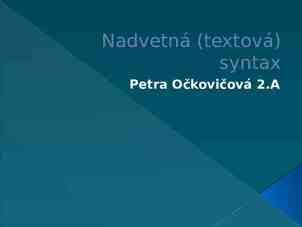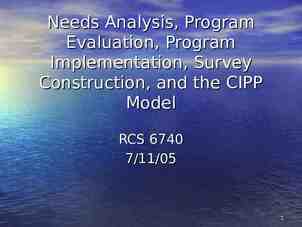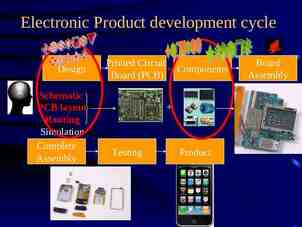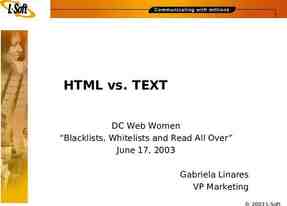Automation & SelfService 05 | What’s New in System Center 2012 R2
26 Slides5.00 MB

Automation & SelfService 05 What’s New in System Center 2012 R2 Jump Start Brannan Matherson Product Marketing Manager Symon Perriman Senior Technical Evangelist

Automation and Self-Service What’s New in System Center 2012 R2 Jump Start The Cloud OS Infrastructure Provisioning Infrastructure Monitoring Application Performance Monitoring Enable enterpriseclass multitenant infrastructure for hybrid environments Comprehensive monitoring of physical, virtual & cloud infrastructure Deep insight into application health Automation and Self-Service Enable application owner agility with IT retaining control IT Service Management Windows Azure Pack Flexible service delivery Azure cloud services in your datacenter

Meet Brannan Matherson Microsoft Product Marketing Manager Windows Server and System Center team Technical subject-matter expert for datacenter automation & IT service management Develops core technical content and product messaging in the management space Technical presenter at internal & external events Background Been with Microsoft since 2008 Previously on Sales & Marketing team focusing on enterprise customers Led worldwide offerings across 13 geographies Worked for IT/Telecom startup Network IT business analyst with San Francisco International Airport

Agenda: Automation & Self Introduction Service Self-Service for the Cloud Tenant System Automation Process Automation Integration

Extreme automation to manage the Cloud Service Manager Orchestrator CMDB Runbooks Knowledg e base Data warehous e Azure Integration Pack External Cloud PowerShel l Workflows Manual and repetitive processes Service Offerings automated by the power of runbooks and PowerShell, using Catalog information stored in the Work Items centralized CMDB Knowledge App Controller SM Portal Templates Configuration Items Systems Center Components Application Owner Tenant Admin

Self-service empowerment “I need it for my myself” team” Quickly spin up &Quickly manage clouds request and spin up clouds Tenant Applicatio User n Owner Automated Service Deployment AppControll Service Manager er SelfSelf-Service Service Portal Request and Request manage capacity capacity Orchestrator automation Service Manager CMBD standardization Manage Manage and Maintain Raiseand Maintain Manage Application Application Resources incidents Resources status Runbooks PowerShell CMDB Service Catalog Templates Services VMs Users

Fill in gaps by automating selfservice Customers face resource and management challenges with too many manual processes and efforts Manual tasks Batch scripts Patch remediation User requests Provisioning Release management Rapid change Application Deployments SLA adherence Capacity management Automating self-service results in lower management overhead and focused scarce resources Decrease in errors and rework Give users fast and easy access to services Reduce manual admin efforts for routine tasks Empower application owners to deploy applications and services consistently and reliably

Self-Service for the Cloud Tenant 05 Automation and Self-Service Microsof t Virtual Click toAcadem edit Masterysubtitle style

Using Self-Service Resources built into the private cloud infrastructure – service catalog: Request Clouds Request capacity Raise incidents Manage status Manage and Maintain Application Resources What is the self-service process I will use to get the services I need? Do you want have existing to manage service your management, own processes environment and applications, changing App Controller (approval, capacity toetc.) match that projects, you don’t andwant processes to Make the request via SM portal, thenManager manage the lose with with changing an team needs? Service cloud via App Controller on-premises private cloud?

Building a comprehensive service catalog Service offerings request Request offerings templates IT service enables that business isofferings being unit for Create request delivered users to request in the services that IT will deploy Service Catalog

Delivering a service end-to-end Service offering Request offerings Work item used to identify and classify standard Contains oneIT orservices Offering created by IT service provider that consumers request Based on a template using the service catalog more request offerings Templates Minimize data entry by The service catalog providing default Standardize processes values Step 1: Create Service Offering Step 2: Create service request template Step 3: Publish Service Offering Step 4: Create Request Offering Step 5: Publish Request Offering Step 6: Add Request Offerings to Service Offerings

System Automation 05 Automation and Self-Service Microsof t Virtual Click toAcadem edit Masterysubtitle style

Deploy cloud services automatically Organizations want to: Manage and control change. Save time and resources. Implement consistent processes. Minimize risk. Automation provides: Runbooks to control Resources thatused are provisioned the same way system tasks across every time. components and A reduction of error-prone manual tasks to implementing standardized lower costs. from Service processes CMDB schema for effectively managing Manager. processes and key data. Enable IT resources to focus on work that adds business value.

Orchestrator as the “automater“ PowerShell Using the Run .Net Script activity you can leverage existing efforts. Create scripts to customize automation processes

Automation concepts Activities Intelligent tasks that perform defined actions Invoke web services Run .NET script Send e-mail Query database Compare values Check schedule Return data Runbooks Databus and nested runbooks System-level workflows that execute a series of linked activities Create incident Create checkpoint Get server ID from DPM E-mail on error Start maint mode Shut down VM Used to publish and consume information as a Runbook executes Update on success Get data sources Create recovery point Standard activities A rich set of out-of-box activities

Built in extensibility and PowerShell Scripting integration PowerShell, VB.NET, C#, Jscript or SSH Why PowerShell? Extension Easy automation Orchestrator toolset can be built up and extended with the Flexibility Flexible activities programmability native to Windows PowerShell. Daily Query tasks database Queries Adhoc reports Complex scripting for Monitor WMI Workflows Flexible with legacy Run program environments (vbscript, console apps) while working with the latest server applications Write to database Query WMI Leverage Invoke web the power of the services Orchestrator data bus Publish yourXML PowerShell variables to the data bus (each Query variable published must be manually entered).

Process Automation 05 Automation and Self-Service Microsof t Virtual Click toAcadem edit Masterysubtitle style

What is process automation and why Automation Process provides automation Runbook s Automate the service processes and systems necessary to the fulfillment of consumer requests Automate routing of requests for approval and notification Automate provisioning of the Provision resources in a repeatable fashion Enable requests and provisioning through selfservice Reduce errors and costs CMDB schema for processes Empowers IT to deliver efficient services

Service delivery and automation architecture Release managemen t Process automatio n Change managemen t Self-service Reporting and insights Incident managemen t CMDB Service catalog Workflows Work items Templates Data warehousing Configuration items Knowledge Orchestrator Automation Integratio n Active Directory Third-party management tools

Process automation simplifies Datacenter Management Standardiz e Processes Processes Consistent, standardized processes from Service Manager Centralized CMDB Optimize and extend existing investments Deliver flexible and reliable services Integration Orchestration Optimize heterogeneous environments with integration packs Easy-to-extend platform for building custom integrations with the integration toolkit Accelerate time to value with flexible process workflows Improve service reliability across multiple tools, systems, and department silos Lower costs and improve predictabilit y Automation Enable IT resources to focus on work that adds business value Reduce error-prone manual activities while lowering costs

Value of a centralized CMDB CMDB information used by Orchestrator Standardized Service Delivery - Bi-directional connectors enable automation activities to come into SCSM, as well as for SCSM to issue and execute those automation workflows within Orchestrator to enable standardized service delivery Service Manager IS the CMDB! - Stores policies and standardized processes and templates Data about the infrastructure, people and processes is the key enabler of automation Standardization reduces mistakes, allows processes to work across the infrastructure and to be automated CMDB enables role based requests for services via selfservice

Integration 05 Automation and Self-Service Microsof t Virtual Click toAcadem edit Masterysubtitle style

Integration Packs for automation across clouds Private Cloud Microsoft Cloud Service Provider Partner enabled IP’s Out-of-the-box Orchestrator integration enables Microsoft and third-party platforms to coordinate and use operational data BMC Kelverion in the infrastructure across varying cloud scenarios (on-premises, Microsoft cloud and service provider clouds) ServiceNow All Systems Dell - AIM Center Components Windows Windows Azure Azure Active Directory SharePoint Data Manipulation SharePoint NetApp - OCPM Exchange Exchange (User (User and and Admin) Admin) FTP HTTP Applications Cisco IBM Tivoli Netcool/Omnibus VMware vSphere UCS HP (OM, SM, iLO) NCM JaxMP/Frysoft New capabilities in -R2 Vision Solutions DoubleTake

Integration across the infrastructure Inbound to System Center Bi-directional from Orchestrator Bi-directional for notifications/reporting Bi-directional Runbook integration Virtual Machine Manager Operations Manager Configuration Manager Orchestrator BI through Reporting and Dashboards Runboo ks Active Directory Notifications via Exchange Microsoft Exchange (Admin User) Azure Cloud Management Third-party Management Tools Service Manager Centralize d CMD B Service Manager Data Warehouse Inbound andcommands Bi-directional Configuration Automation outbound connector items andnotifications issued for automation automation to System and data activities Intelligence populated Center, Business and intoexecuting CMDB automation workflows third-party tools, Microsoft Exchange and Azure

Summary Self-Service for the cloud tenant System Automation Process Automation Integration Orchestrator and Service Manager: Efficiently automate service deliv

2013 Microsoft Corporation. All rights reserved. Microsoft, Windows, Office, Azure, System Center, Dynamics and other product names are or may be registered trademarks and/or trademarks in the U.S. and/or other countries. The information herein is for informational purposes only and represents the current view of Microsoft Corporation as of the date of this presentation. Because Microsoft must respond to changing market conditions, it should not be interpreted to be a commitment on the part of Microsoft, and Microsoft cannot guarantee the accuracy of any information provided after the date of this presentation. MICROSOFT MAKES NO WARRANTIES, EXPRESS, IMPLIED OR STATUTORY, AS TO THE INFORMATION IN THIS PRESENTATION.






